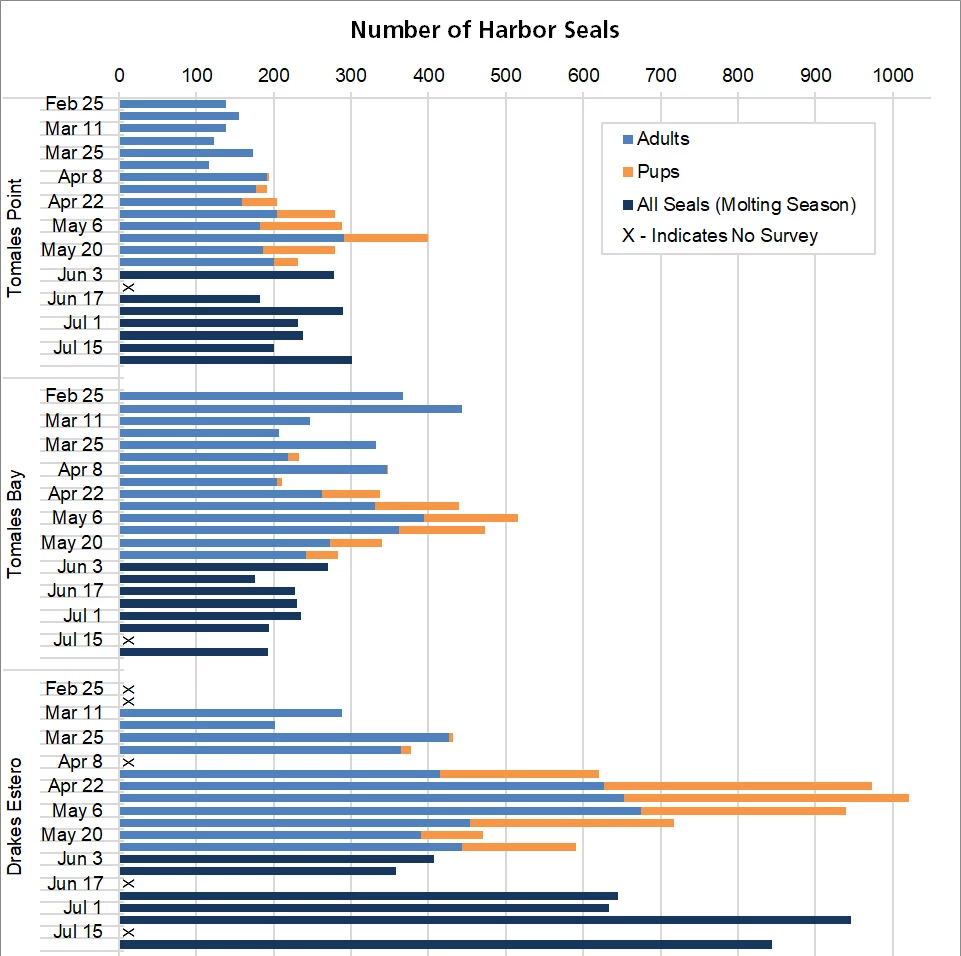Last updated: August 15, 2019
Article
2019 Harbor Seal Monitoring Updates
Breeding Season Summary
The 2019 harbor seal pupping season (March–May) was an average one. The maximum number of pups recorded during Pinniped Monitoring Program surveys at the main Marin County locations was approximately 1,060. That count is very similar to the baseline average of 1,100 pups. Drakes Estero was the most popular pupping site, with 368 pups recorded. This is an average count for Drakes Estero, but biologists saw an increase in the number of pups at Bolinas Lagoon, and decreases in pups at Double Point and Tomales Point, compared to their respective site averages. Very low pup mortality was recorded, indicating a successful season.

NPS / Kris Liang
Molting Season Summary
Following the pupping season, the seals are monitored during the molt season (June–July). During this time, all age groups come ashore at the main haul-outs to shed their fur. This gives biologists a good estimate of the total number of seals at the main Marin County locations. In 2019, the maximum number of seals recorded during the molt season was approximately 2,800, which is less than the baseline average of 3,670 seals and follows the past two years of low counts. All sites had a decrease in seals compared to their respective averages except Bolinas Lagoon, Duxbury Reef, and Point Bonita. Bolinas Lagoon has had higher than average counts since 2014, while Double Point has had extremely low counts since 2016. The peak counts recorded at Tomales Bay and Tomales Point were among the lowest counts ever recorded at each of those sites. The reasons for the decreases at these sites are unknown. During the molt season, the sites with the highest number of seals recorded was Drakes Estero (940) and Bolinas Lagoon (615).
Preliminary Data
2019 Maximum Harbor Seal Count By Site

Maximum Harbor Seal Pup Counts, 2000-2019

Maximum Harbor Seal Molt Counts, 2000-2019

The Details: 2019 Weekly Maximum Harbor Seal Counts By Site


For More Information
Contact
Webpages
San Francisco Bay Area Network - Pinniped Monitoring
Pacific Coast Science and Learning Center - Harbor Seals
The National Park Service shall not be held liable for improper or incorrect use of the data described and/or contained herein. These data and related graphics are not legal documents and are not intended to be used as such. The information contained in these data is dynamic and may change over time. The data are not better than the original sources from which they were derived. It is the responsibility of the data user to use the data appropriately and consistent within the limitations of geospatial data in general and these data in particular. The related graphics are intended to aid the data user in acquiring relevant data; it is not appropriate to use the related graphics as data. The National Park Service gives no warranty, expressed or implied, as to the accuracy, reliability, or completeness of these data. It is strongly recommended that these data are directly acquired from an NPS server and not indirectly through other sources which may have changed the data in some way. Although these data have been processed successfully on computer systems at the National Park Service, no warranty expressed or implied is made regarding the utility of the data on other systems for general or scientific purposes, nor shall the act of distribution constitute any such warranty. This disclaimer applies both to individual use of the data and aggregate use with other data. The National Park Service requests that the data user refrain from publishing these data and related graphics and wait until data is available in official, published reports.
